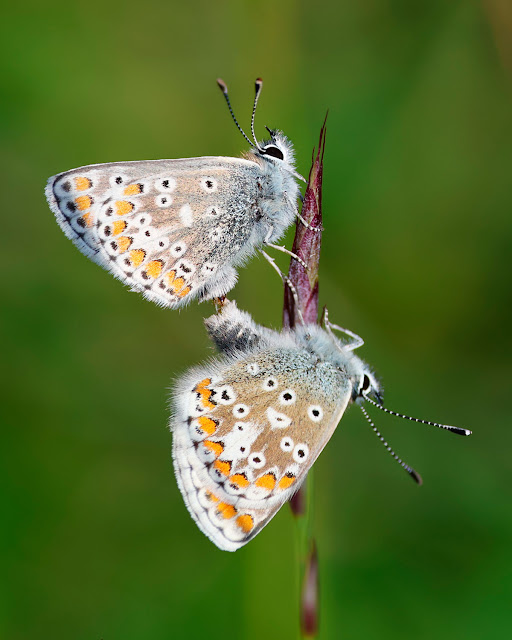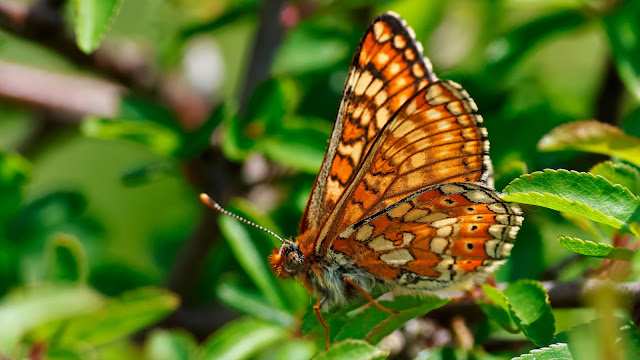Part two of the day at Martin Down doesn't really start until we came back off the Jubilee Trail and turned left to walk the Ditch again. Here you walk through a small clump of bushes and climb a hill, on the right hand side is a sheltered spot and is usually in full sun, it is always worth checking as the butterflies have the opportunity to warm up and can be found quite early in the morning. Today was no different. As I walked around staring at the ground a caught a flash of blue from the corner of my eye. At first I thought I had imagined it, but then it appeared again, it settle down and opened the wings, the first butterfly of the day, and also the first blue of the year was a smart male Adonis Blue.
The males have brilliant sky-blue wings, while the females
are chocolate brown and far less conspicuous. Both sexes have distinctive black
lines that enter or cross the white fringes of the wings.
The males have brilliant sky-blue wings, while the females are chocolate brown and far less conspicuous. Both sexes have distinctive black lines that enter or cross the white fringes of the wings.
The Adonis Blue overwinters as a caterpillar; and they feed on Horseshoe Vetch during the day. It is most commonly seen during April and late July as it searches for ants to 'milk' its sugary secretions.
In April-May and July-August the caterpillar forms into a
chrysalis in small crevices or hollows and is then buried by ants in earth
chambers connected to the ant nest. The ants constantly attend to it for around
three weeks, protecting it from predators.
A good start to the first real butterfly day of the season, next was a Grizzled Skipper always a good looking butterfly to find at this time of year.
The Grizzled Skipper is a characteristic spring butterfly of
southern chalk downland and other sparsely vegetated habitats. Its rapid,
buzzing flight can make it difficult to follow, but it stops regularly either
to perch on a prominent twig or to feed on flowers such as Common
Bird's-foot-trefoil or Bugle. It can then be identified quite easily by the
checkerboard pattern on its wings.
The Common Blue is the most widespread blue butterfly in
Britain and Ireland and is found in a variety of grassy habitats.
Unlike Adonis and Chalkhill Blues, the dark veins do not
extend into white fringes of wing margins.
The Brown Argus is characteristic of southern chalk and limestone grassland but occurs in a variety of other open habitats as far north as north Wales and Yorkshire. The Brown Argus is a member of the "blues" family, but unlike most other "blues", the Brown Argus has no blue scales on its upperside, both sexes being primarily brown in colour as its common name suggests, although the butterfly does exhibit a blue sheen when at certain angles to the light.
Males are territorial and can be seen basking on bare ground
or rock waiting for females, every now and again chasing off other insects that
encroach on their space.
The Small Copper is on the wing throughout the summer between April and October. They can have up to three broods in the year.
The Brown Argus generally has 2 broods a year in central and
southern England, with only a partial second brood in north Wales and the north
of England. In good years, a partial 3rd generation may appear in the south.
The adults emerge first in central and southern England in early May, peaking
at the end of May and beginning of June, and giving rise to a second brood that
emerges at the end of July and into August
When courting, the males congregate at the base of a slope
where they either perch, waiting for a virgin female to fly by, or patrol the
area looking for a female perched on a grass stem awaiting a mate. Mating takes
place after a short flight low to the ground. When egg-laying, the female will
make meandering flight close to the ground, searching out suitable foodplants
on which to lay.
The next crossroads is where the ditch crosses with the bridleway known bizarrely as Bowling Green Lane. Despite the name it is a very narrow track and where the ditch path crosses there is a nice open sheltered spot and it was here that we found the first Small Blues.
This is the UK’s smallest resident butterfly with a wing span that can be a little as 16mm and is easily overlooked, partly because of its size and dusky colouring, but partly because it is often confined to small patches of sheltered grassland where its sole foodplant, Kidney Vetch, is found.
Males perch on small shrubs or grass stems which they leave
when investigating passing insects or when searching out nectar sources. They
are not territorial, however, and can often be found in small groups of two or three.
The sexes are similar in appearance, although the male
upperside is almost black with a dusting of blue scales, whereas the female is
more dark brown in colour. Both sexes have an underside that is silvery-grey in
colour, and not unlike that of the Holly Blue.
On reaching the rifle ranges we went in search of a Green Hairstreak we had been told of. This involved searching the gorse and small clear chalk pits while being scolded by a pair of Stonechats, but with no success in finding the elusive butterfly.
Rather than walk on we decided to turn back and follow the ditch back to whence we had come. The target species was the Marsh Fritillary and it was surprising we had not encountered any so far this morning. This time last year they were reaching the end of their flight, but with every thing late this year we expected to find some, but as yet nothing.
A Holly Blue appeared around the May blossom and provided a brief view amongst the white flowers. This is the blue butterfly most likely to be found in gardens, as well as woodlands, parks and churchyards. It tends to fly high around bushes and trees, whereas other grassland blue butterflies fly low to the ground.
A little further along we had better views as one appeared in the ditch.
The Holly Blue emerges in early spring, from March to May,
and then again at the end of the summer between July and September. The
foodplants of the caterpillars are mainly Holly (for the spring generation) and
Ivy (for the summer generation), although a wide range of other plants are used
including spindle, bramble and gorse.
In previous years at this time of the season Small Heath are normally plentiful, but it wasn't until the return walk that we found our first of the day. An inconspicuous butterfly that flies only in sunshine and rarely settles more than a metre above the ground. Its wings are always kept closed when at rest.
The Green Hairstreak is the most widespread of our
hairstreaks. However, it is also a local species, forming distinct colonies
which can be as small as a few dozen individuals, although other colonies can
be much larger. There is some indication
that this year will be a good year for the Green Hairstreak, something that was
reinforced by the number we saw on the walk, five which is the highest I have
seen here at Martin Down
The Green Hairstreak holds its wings closed, except in
flight, showing only the green underside with its faint white streak. The
extent of this white marking is very variable; it is frequently reduced to a
few white dots and may be almost absent, as is the case with this individual. It regulates its body temperature by tilting
its wings appropriately to catch the sun's rays.
Males and females look similar and are most readily told apart
by their behaviour: rival males may be seen in a spiraling flight close to
shrubs, while the less conspicuous females are more often encountered while
laying eggs.
The male of this species is territorial and will have
favourite perching sites that it uses to wait for passing females, but will
dart out to investigate any passing object. The perches may be on standalone
shrubs or part of a hedge and are often reused by different males should the
original occupants wander too far.
The Green Hairstreak can be found in a wide variety of
habitats, including hillsides, moorland, chalk downland, heathland, railway
embankments and valley bottoms. A common feature of all these habitats is the
presence of scrubby plants and hedgerows.
As a result it has the widest range of foodplants of any British butterfly,
which includes Bilberry, Bird's-foot Trefoil, Broom, Common Rock-rose, Dogwood,
Bramble and Gorse.
The colouration of this moth may vary slightly in the number
and extent of the brown blotches on the wings but it remains easily
recognisable from other species. Flies frequently during the day, especially in
the sunshine.
The pearl-bordered fritillary is a striking orange-and-black
butterfly of sunny woodland rides and clearings. It gets its name from the row
of 'pearls' on the underside of its hindwings.
It is often seen flying close to the ground along sunny
woodland rides or feeding on spring flowers such as common dog-violet. It can
also be found in habitats with a mosaic of grass, bracken and scrub.
It is the earliest fritillary to emerge in April and may
even have a second brood if the weather is good. The female lays single eggs in
bracken or leaf litter close to violets, the foodplant of the caterpillars.
The Marsh Fritillary has the most colourful uppersides of
all of our fritillaries, being a highly-variable chequered pattern of orange,
brown and yellow markings. The bright colours fade after a few days and leaves
the butterfly with a shiny appearance.
The Marsh Fritillary uses several different types of
habitat, including chalk hillsides, heathland, moorland and damp meadows. A
factor common to all habitats is that they are in full sun, their higher
temperature aiding larval development. The network of small streams and boggy patches is ideal here at Bentley
The Marsh Fritillary was once widespread in Britain and
Ireland but has declined severely over the twentieth century. The Marsh
Fritillary populations are highly volatile and the species requires extensive
habitats or habitat networks for its long term survival.
Colonies of this butterfly are known to fluctuate wildly in
numbers. It may be present in some numbers one year, for the population to
crash the following year before recovering as unexpectedly. This species does
not do well in adverse weather conditions and also suffers greatly from larval
parasitism by an Apanteles species of wasp.
As for most butterfly species, the males emerge a few days
before the females and set up small territories centred on a particular plant
or flower. They will dart up to investigate any passing butterfly flying
nearby. They will also patrol suitable areas, in the hope of finding a
newly-emerged female. Once a female is found, the male flutters around her for
a short while before mating takes place.
The Broad-bodied chaser is a medium-sized, broad-bodied
dragonfly that is on the wing from May to July, and occasionally into August.
The broad, flattened body of the Broad-bodied chaser is
distinctive and makes this dragonfly appear 'fat'. The male has a powder-blue
body with yellow spots along the sides and a dark thorax; the female is
greeny-brown with yellow spots.
The Brimstone is a fairly large, pale yellow butterfly, with
distinctive, leaf-shaped wings.
They can be found in damp woodlands, along sunny, woodland
rides and mature hedgerows, and in large gardens. The foodplants of the larvae
are buckthorn and alder buckthorn. Both shrubs are found in wet woodland, while
buckthorn also occurs on dry chalk and limestone soils.







































_MG_5271.jpg)
























No comments:
Post a Comment